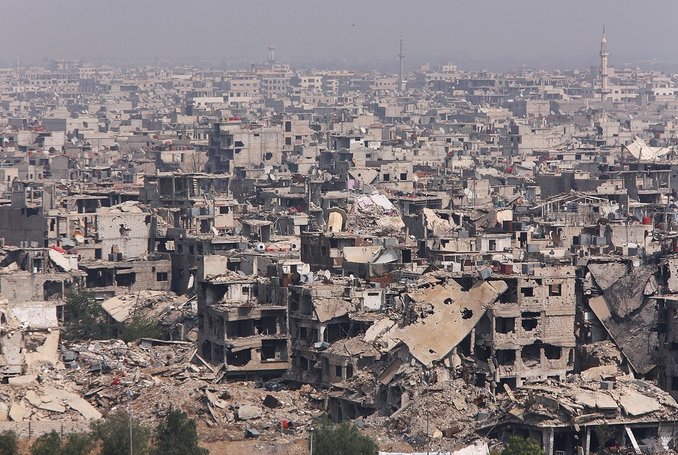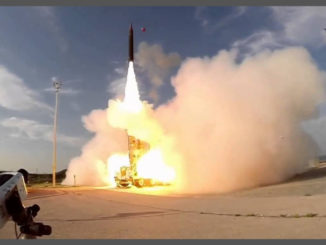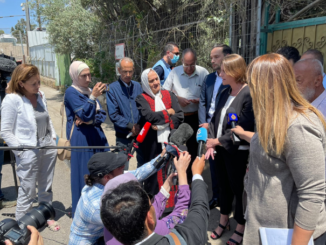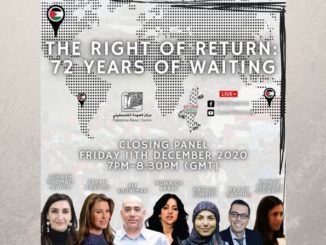
Not far from his destroyed home in Syria’s Yarmouk camp for Palestinian refugees, 21-year-old Abdallah al-Harith dabs bright red paint onto a canvas standing amid the grey ruins.
Last week, he was among 12 young artists to set up their easels in the once-crowded camp turned Damascus suburb, now largely abandoned after seven years of civil war. Equipped with paintbrushes and pencils, they set out to translate suffering into art in a neighborhood ravaged by years of bombardment and siege.
Palestinian artists embodying the suffering in the #Yarmouk refugee camp in #Syria ࿐art & painting as a way of managing & processing trauma & suffering ❤️???? #Art#GroupPalestine#قروب_فلسطيني pic.twitter.com/pcYtO4JpmH
— ✖️???? Ᾰฑฑ༈℮ ????✖️ (@Betelgeuse100) August 23, 2018
“We’re bringing back life to a dark place,” said Harith, who fled Yarmouk several years ago, but returned after the regime ousted Islamic State group jihadists in May. “I had such a lump in my throat when I first came back to the camp. At first, I couldn’t draw anything,” said the fine arts student. “But then I realized that any glimpse of life amid all this death was a victory,” he said, gesturing towards the battered buildings around him.
He and his peers stood sweeping paint across their canvases while the gentle melody of an oud — a Middle Eastern lute — was broadcast across the smashed concrete.
31# Syrian artists draw paintings amid the rubble and destruction of the Yarmouk Camp, Syria. Those artists chose to draw paintings of women, children, buildings or anything that could add life to the Yarmouk Camp, which was once a home for Palestinians and Syrians pic.twitter.com/jY8nw1AJMq
— Xinhua Hindi News (@xinhua_hindi) August 19, 2018
Harith painted an image of a small boy emerging from the ground, holding a bright red apple. Harith said:
“It’s supposed to represent new life. I actually saw something like this once: children with apples playing again on what had been fighting ground.”
Before the war, Yarmouk was home to around 160,000 people, the United Nations says. Set up in 1957 to house Palestinian refugees, over the decades it became a crowded district that was eventually swallowed up by Damascus, but today it lies almost abandoned.
Refugee artists return to Syria's Yarmouk camp to depict dreams https://t.co/pt11z75W8V pic.twitter.com/1u25JtBybD
— Iranpowerful (@Iranpowerful3) August 18, 2018
Around 140,000 residents fled clashes between the regime and rebels in 2012, leaving the rest to face severe food shortages under government encirclement.
In 2014, a harrowing photograph of gaunt-looking residents massing between ravaged buildings to receive handouts caused global outrage. Earlier this year, fighting between loyalists and jihadists displaced most of the remaining residents, according to the United Nations’ agency for Palestinian refugees, UNRWA.
On Saturday, the work of the young artists was displayed at the entrance of the Yarmouk camp, with a small crowd making the trip to see it.
"Home will never be home again" #yarmouk #refugee camp,Damascus #Syria,by British Syrian artist Diana AL #Palestine pic.twitter.com/rGFHUJpTMD
— Shaista Aziz (@shaistaAziz) October 20, 2015
Painter Hinaya Kebabi depicted a young boy with a missing eye, holding up a drawing of another eye to conceal his wound, the 22-year-old explained. She said:
“One day, I hope people will come back here to color, not rubble.”
One painting depicted streams of red running down a dark building. In another, an emaciated man was curled up naked in the fetal position. After the images were shared online, several internet users slammed the project as provocative.
"Our goal is to return the life to this place that was almost dead"
Discover the painters of Yarmouk, #Syria who are using art to express their suffering due to war and bring beauty back to what was once home. https://t.co/4zE1lKu8AV
— GOAL Global (@GOAL_Global) August 23, 2018
“The camp is neither romantic nor a place for drawing,” 28-year-old Abeer Abassiyeh said, as most former residents remain unable to return to their homes.
But Mohammed Jalbout, one of the organizers who hails from the Palestinian camp, defended the project.
He commented:
“We all have homes here. I haven’t been back to mine or been able to inspect it, but at least through art, we’re trying to breathe a little life back into this place.”
(TeleSur, PC, Social Media)








